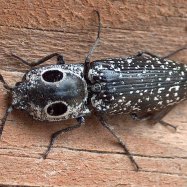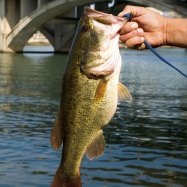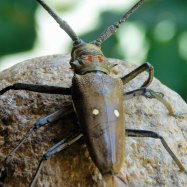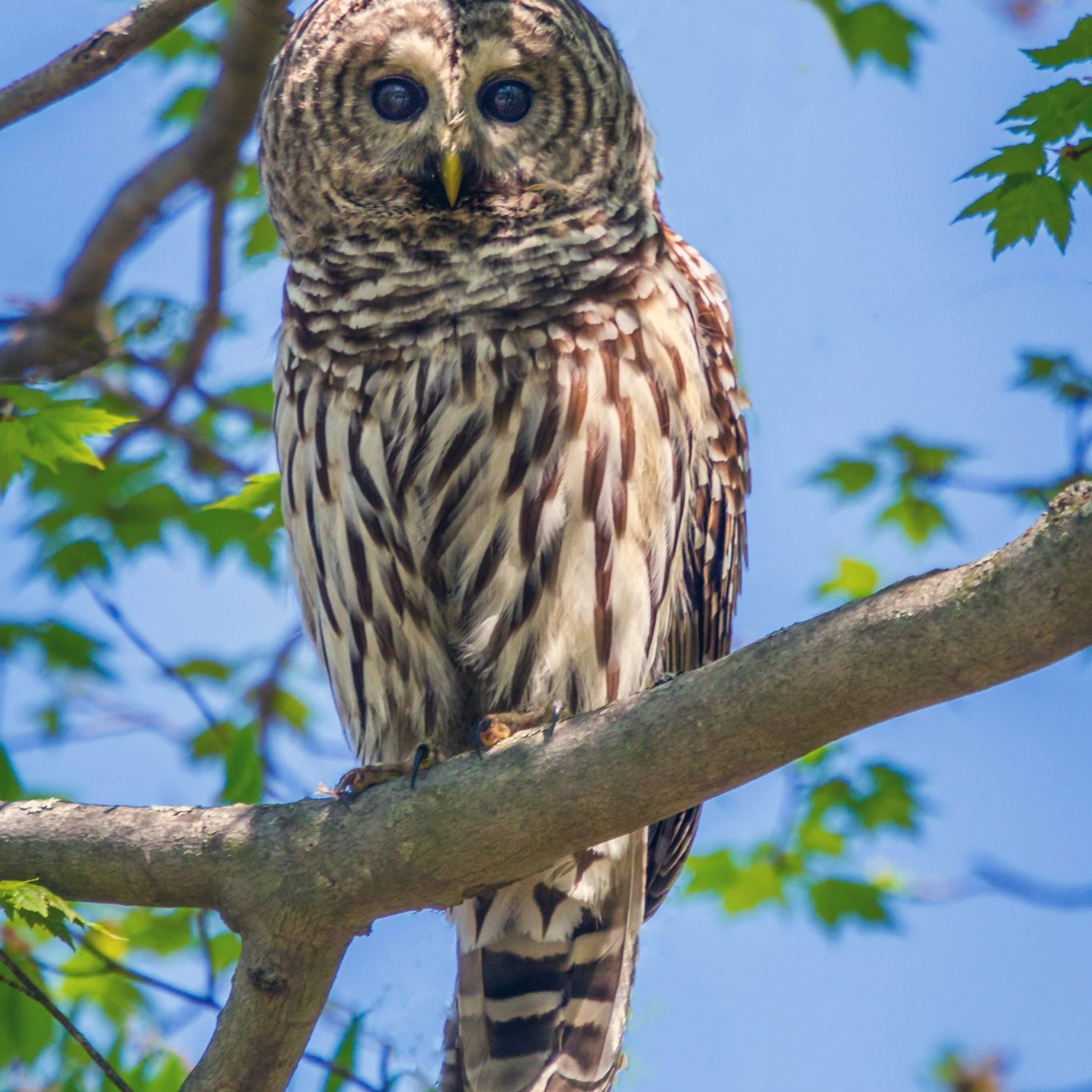
Barred Owl
40-63 cm
Barred Owls are known for their distinctive barred feathers and haunting hoots. These majestic creatures can be found in the eastern and southern parts of North America. With a length ranging from 40 to 63 cm, they have a stocky body shape and belong to the Strigidae family. Keep an eye out for these beautiful birds on your next nature hike! #BarredOwl #NorthAmerica #Strigidae #StockyBody
Animal Details Summary:
Common Name: Barred Owl
Kingdom: Animalia
Habitat: Forests, woodlands, swamps
Meet the Barred Owl: Master of the North American Forests
As you wander through the thick forests of North America, you may come across a strikingly beautiful bird with piercing golden eyes and distinct brown and white markings. This is the Barred Owl, also known by its scientific name Strix varia, a masterful hunter of the woodlands and swamps.Origin and Geographical Distribution
The Barred Owl is a native of the United States, primarily found in eastern and southern parts of North America. Its range extends from southern Canada to as far south as Mexico, and it is even known to occasionally migrate further north during the colder months Barred Owl. This majestic bird can also be found in parts of Central America.Appearance and Anatomy
The Barred Owl is a medium-sized owl, with a stocky body and large, powerful talons. It can range in size from 40 to 63 centimeters in length, making it one of the larger owls in North America. Its wingspan can reach up to 1.2 meters, and it can weigh between 500 to 1000 grams.One of the most striking features of the Barred Owl is its distinct brown and white barred markings, giving it its common name. These markings are not only aesthetically pleasing but also play an important role in camouflage. When perched against a tree trunk, the owl's markings help it blend in seamlessly with its surroundings, making it nearly invisible to potential prey.
Habitat and Behavior
The Barred Owl is a versatile bird that can thrive in a variety of habitats, including forests, woodlands, swamps, and even urban areas Black Sea Bass. However, they do require large, mature trees for nesting and roosting, making them more prevalent in older, undisturbed forests.Despite their large size, Barred Owls are known for their silent flight as they swoop down on unsuspecting prey. They are opportunistic hunters and their diet consists mainly of small mammals, such as rodents, rabbits, and even smaller birds.
Reproduction and Family Life
Barred Owls are monogamous birds, who mate for life. They typically form their pair bonds during their first year of life and remain together for the duration of their lives, which can be up to 10 years in the wild.During the breeding season, which typically begins in late winter or early spring, the male Barred Owl will establish a territory and attract a mate through hooting calls. The pair will then work together to build a nest, usually in a tree cavity or abandoned hawk or squirrel nest.
After the female lays 2-4 eggs, both parents will take turns incubating the eggs for approximately 28 days. Once the eggs hatch, both parents will continue to care for and feed the chicks until they fledge at around 6-7 weeks old.
Tips for Spotting a Barred Owl
If you're interested in catching a glimpse of this magnificent bird, here are a few tips to increase your chances:- Take a walk in mature, wooded areas with large trees.
- Listen for their distinctive "Who cooks for you?" hooting calls.
- Look for their distinctive brown and white barred markings.
- Scan the treetops, especially near dawn and dusk when they are most active.
Role in Ecosystem
As top predators, Barred Owls play a critical role in regulating the population of their prey, which helps maintain the balance of the ecosystem. They also provide a source of food for other predators, and their presence can indicate the health of the surrounding habitat.Threats and Conservation Status
Unfortunately, like many other bird species, Barred Owls face threats from habitat loss and fragmentation due to deforestation and urbanization. Expansion of roads and highways also poses a significant danger to these birds, as they are often struck by vehicles while hunting on roadsides.However, due to their wide geographic range and adaptability, Barred Owls are not currently considered a threatened species. Nevertheless, it's important to continue monitoring their populations and protect their habitats to ensure their long-term survival.
Interesting Facts
- Barred Owls are one of the few owl species that do not have ear tufts.- They have been known to hunt cooperatively with their mates or even with other owl species.
- Barred Owls are not migratory birds, but they may move to different areas within their range in search of food.
- These birds are not shy and can often be found near human habitations, sometimes even perching on backyard bird feeders.
The Fascinating World of the Barred Owl
In conclusion, the Barred Owl is a fascinating bird that has captured the hearts of many with its beauty, intelligence, and adaptability. From its essential role in the ecological balance of the North American forests to its impressive hunting skills, this owl has proven to be a true master of its environment.Whether you're an avid bird-watcher or simply someone who appreciates nature's wonders, encountering a Barred Owl in the wild is an experience that is sure to leave a lasting impression. So next time you're out exploring the forests of North America, keep your eyes and ears open for the call of the majestic Barred Owl.

Barred Owl
Animal Details Barred Owl - Scientific Name: Strix varia
- Category: Animals B
- Scientific Name: Strix varia
- Common Name: Barred Owl
- Kingdom: Animalia
- Phylum: Chordata
- Class: Aves
- Order: Strigiformes
- Family: Strigidae
- Habitat: Forests, woodlands, swamps
- Feeding Method: Carnivorous
- Geographical Distribution: North America
- Country of Origin: United States
- Location: Eastern and southern parts of North America
- Animal Coloration: Brown and white
- Body Shape: Stocky
- Length: 40-63 cm
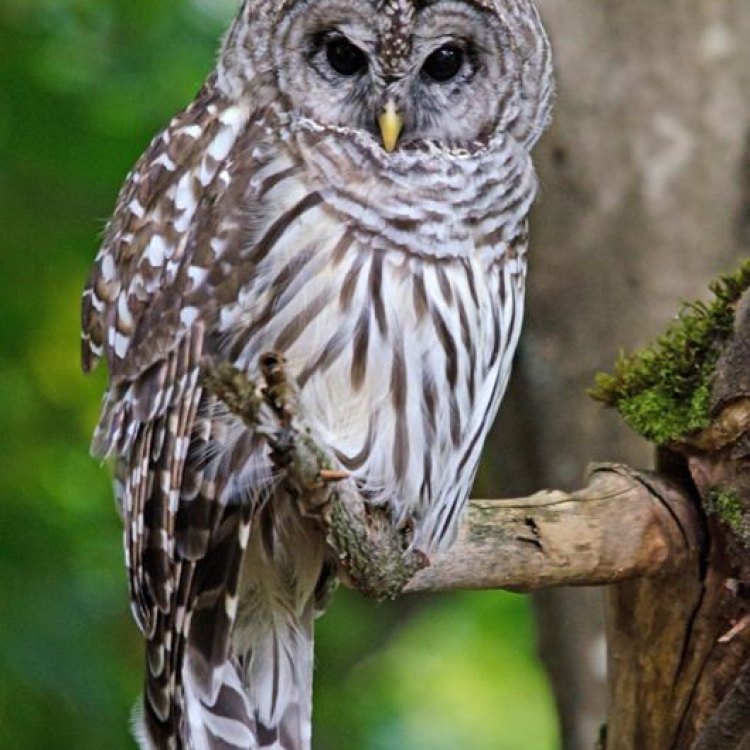
Barred Owl
- Adult Size: Medium-sized owl
- Average Lifespan: 10-15 years
- Reproduction: Egg-laying
- Reproductive Behavior: Monogamous
- Sound or Call: Deep hooting sound
- Migration Pattern: Non-migratory
- Social Groups: Solitary or in small groups
- Behavior: Nocturnal
- Threats: Habitat loss, collisions with vehicles
- Conservation Status: Least Concern
- Impact on Ecosystem: Top predator
- Human Use: None
- Distinctive Features: Dark brown streaks on white underparts, prominent facial disc
- Interesting Facts: Has one of the most distinctive calls of any owl species
- Predator: No natural predators
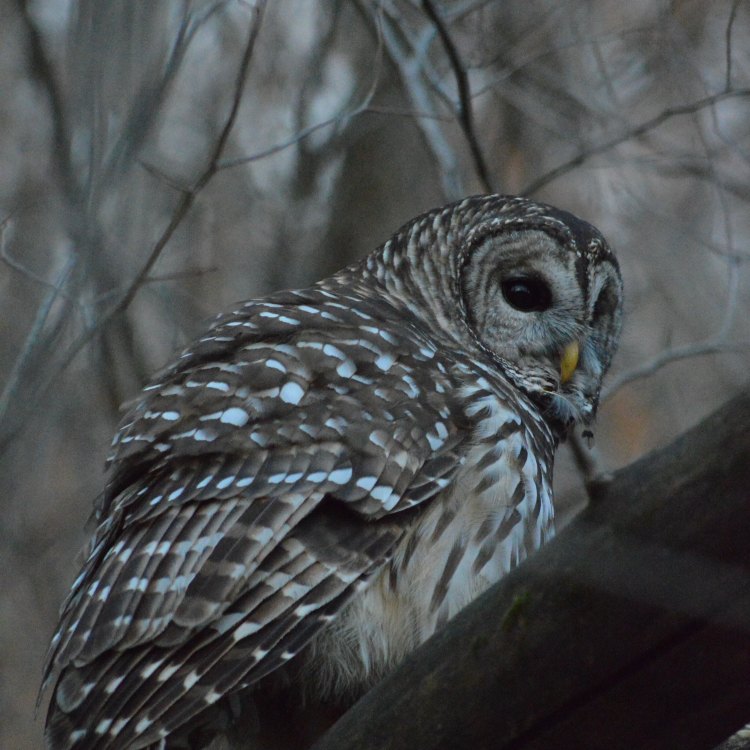
Strix varia
The Barred Owl: A Fascinating Creature of the Night
The forests are shrouded in darkness as the stars twinkle above. A deep hooting sound breaks the silence, sending shivers down the spine. It is the call of the Barred Owl, a mysterious and majestic bird of prey. With its dark brown streaks on white underparts and prominent facial disc, this medium-sized owl has captivated the imagination of people for centuries PeaceOfAnimals.Com. But do we truly know everything about this enigmatic creature? In this article, we will delve deep into the world of the Barred Owl and uncover its unique features, behavior, and impact on the ecosystem.The Barred Owl - A Medium-Sized Owl
The Barred Owl, also known as the Northern Barred Owl or Strix varia in the scientific community, is a medium-sized owl that belongs to the Strigidae family. It is native to North America and can be found across the eastern portion of the continent, from the Great Plains to the Atlantic coast. The owl is approximately 16-25 inches long, with a wingspan of 38-50 inches. Its size makes it smaller than some of its owl relatives, such as the Great Horned Owl and the Snowy Owl, but it is still an impressive predator.Unraveling the Mystery of Its Lifespan
When it comes to lifespan, the Barred Owl is relatively long-lived compared to other bird species. On average, they live for 10-15 years in the wild, with the oldest recorded Barred Owl reaching the ripe age of 24. However, their lifespan can greatly vary depending on their location and living conditions. In captivity, they can live for up to 28 years, while in some areas with harsher climates, their lifespan may be shorter Black Capped Chickadee.Egg-Laying Reproduction and Monogamous Behavior
Like most owl species, the Barred Owl follows a monogamous mating system, meaning that they have one partner for their entire lifetime. They usually mate for life, and if one of the partners dies, they will find a new mate. The breeding season for Barred Owls begins between February and April, with the female laying 2-4 eggs in a nest built in a tree cavity or an abandoned nest of another bird species. The male will gather food and bring it to the female while she incubates the eggs for approximately 28-33 days. Once the eggs hatch, both parents will provide food for the hatchlings. The young owls will leave the nest after about 4-5 weeks, but they may still be dependent on their parents for another 4-5 months.Deep Hooting Sound - A Signature Call
One of the most distinctive features of the Barred Owl is its call. The deep hooting sound, often described as "who cooks for you, who cooks for you all," is a signature of this species. The male and female Barred Owls have slightly different hoots, with the male's call being lower and slightly faster than the female's. The owl's call is not only used for communication but also to establish territory and attract a mate during breeding season. Their call can be heard for miles, making them one of the most vocal owl species.Staying Put - Non-Migrating Nature
Unlike some bird species, the Barred Owl does not migrate and prefers to stay within their territory all year round. They are considered non-migratory, and instead of traveling to warmer areas during winter, they adapt to their habitat. However, there may be some movement within their territory to seek out food sources or avoid harsh weather conditions.From Solitary to Small Groups - Social Behavior of Barred Owls
Barred Owls are mostly solitary creatures, only coming together with their mate during breeding season. However, they may also be seen in small groups of 2-3 individuals, usually consisting of family members. These social groups are more common in winter when food sources may be scarce, and the owls can cooperate to hunt.The Nocturnal Life of Barred Owls
As with most owls, the Barred Owl is a nocturnal creature, meaning that they are active at night. They have adapted to have excellent vision in low light conditions, thanks to their large eyes and keen eyesight. Their excellent night vision, combined with their sharp talons and powerful beak, makes them skilled hunters, capturing prey such as mice, voles, and other small mammals.Threats and Conservation Status of the Barred Owl
While the Barred Owl may not have any natural predators, they do face several threats in the wild. The biggest threat to these birds is habitat loss due to deforestation and urbanization. As their territories shrink, they may come into contact with humans, leading to collisions with vehicles. Another threat is the competition for resources with their close relative, the Spotted Owl. The Spotted Owl is listed as a vulnerable species, and the Barred Owl's expansion into its territory is a cause for concern.Currently, the conservation status of the Barred Owl is classified as "Least Concern" by the International Union for Conservation of Nature (IUCN). However, ongoing efforts are being made to protect their habitats and monitor their populations to ensure that their status does not change in the future.
The Top Predator of the Ecosystem
As top predators, Barred Owls play a vital role in maintaining the balance of the ecosystem. They help control the populations of small mammals and other prey species, which can have a significant impact on the environment if not kept in check. Additionally, their nesting activities provide shelter for other animals, and their droppings serve as natural fertilizer, contributing to the health of the ecosystem.Fascinating Facts about the Barred Owl
Apart from its distinctive call and solitary nature, the Barred Owl has many other intriguing features and behaviors that make it stand out. For example:- Barred Owls do not have a strong sense of smell, so they rely on their keen eyesight and hearing to capture their prey.
- They are silent flyers, thanks to the specialized feathers on the leading edge of their wings that break up air currents.
- Barred Owls have excellent camouflage, with their dark brown streaks blending in with the tree bark in their habitat.
- These owls have asymmetrical ear openings, allowing them to pinpoint the location of their prey with precision.
The Barred Owl and Its Relationship with Humans
Despite being a fascinating creature, the Barred Owl does not have any significant human use. While their feathers were used in Native American rituals and their calls have been featured in movies and books, they do not have any commercial value or purpose for humans. However, their presence in the wild and their unique features have captured the attention of birdwatchers and wildlife enthusiasts, making them important for ecotourism.In Conclusion
The Barred Owl is a mysterious and majestic creature that has fascinated people for generations. With its unique features, behavior, and impact on the ecosystem, this owl remains an intriguing and essential part of our natural world. As we continue to learn more about this enigmatic bird, it is important to ensure that its habitat is protected and conserved, allowing it to thrive in the wild for generations to come. After all, we could all use a little mystery in our lives.

Meet the Barred Owl: Master of the North American Forests
Disclaimer: The content provided is for informational purposes only. We cannot guarantee the accuracy of the information on this page 100%. All information provided here may change without prior notice.


